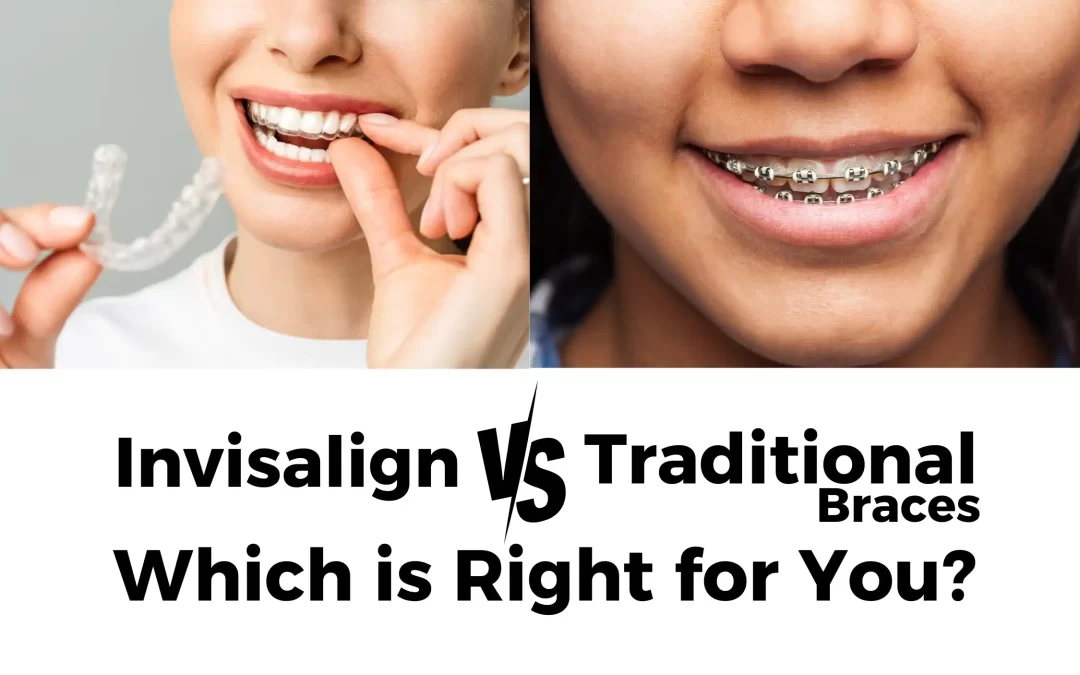When it comes to straightening teeth and achieving a perfect smile, you have more options than ever before. Two of the most popular choices are Invisalign and traditional braces. Each has its own set of advantages and disadvantages, and the best option for you will depend on your specific needs, lifestyle, and preferences. In this blog, we’ll explore the key differences between Invisalign and traditional braces to help you make an informed decision.
What Are Traditional Braces?
Traditional braces have been used for decades to correct dental misalignments. They consist of metal brackets glued to the teeth, connected by wires and rubber bands. Over time, these components apply pressure to the teeth, gradually moving them into the desired position.
Advantages of Traditional Braces
1. Effective for Complex Cases: Traditional braces are highly effective for correcting a wide range of dental issues, including severe misalignments, overcrowding, and bite problems.
2. Constant Pressure: Braces provide constant pressure, ensuring that teeth are consistently moving towards the desired position.
3. No User Compliance Required: Once installed, braces work 24/7 without requiring any action from the user, which can be beneficial for those who might forget to wear aligners.
Disadvantages of Traditional Braces
1. Aesthetic Concerns: The metal brackets and wires are highly visible, which can be a source of self-consciousness for some people.
2. Discomfort: Braces can cause discomfort and irritation inside the mouth, especially after adjustments.
3. Dietary Restrictions: Certain foods, like sticky candies and hard nuts, need to be avoided as they can damage the braces.
4. Hygiene Challenges: Brushing and flossing require extra effort and special tools to clean around the brackets and wires effectively.
What Is Invisalign?
Invisalign is a modern alternative to traditional braces that uses a series of clear, removable aligners to straighten teeth. These aligners are custom-made to fit your teeth and are replaced every one to two weeks to gradually shift your teeth into place.
Advantages of Invisalign
1. Aesthetic Appeal: Invisalign aligners are virtually invisible, making them a popular choice for adults and teens who want to straighten their teeth discreetly.
2. Comfort: Made from smooth plastic, Invisalign aligners are generally more comfortable than metal braces and cause less irritation to the gums and cheeks.
3. Removable: You can remove the aligners when eating, drinking, brushing, and flossing, which makes maintaining oral hygiene easier and allows you to enjoy your favorite foods without restrictions.
4. Convenience: Invisalign aligners are easy to remove and clean, and you don’t need to visit the orthodontist as frequently for adjustments.
Disadvantages of Invisalign
1. User Compliance: For Invisalign to be effective, you must wear the aligners for 20-22 hours per day. Forgetting to wear them or removing them too often can prolong the treatment time.
2. Not Suitable for All Cases: Invisalign is ideal for mild to moderate orthodontic issues. Severe misalignments or bite problems may still require traditional braces.
3. Cost: Invisalign can be more expensive than traditional braces, depending on the complexity of the treatment and your location.
Which Is Right for You?
Choosing between Invisalign and traditional braces depends on several factors, including the severity of your dental issues, your lifestyle, and your personal preferences.
Considerations for Traditional Braces
Complex Dental Issues: If you have severe misalignments, significant bite problems, or other complex dental issues, traditional braces might be the better option. They provide the necessary force and control to address these issues effectively.
No Compliance Concerns: If you’re worried about remembering to wear aligners or don’t want to deal with the responsibility of removing and replacing them, traditional braces offer a no-fuss solution that works continuously without needing user intervention.
Cost-Effectiveness: Traditional braces are often more affordable than Invisalign, making them a practical choice for budget-conscious patients.
Considerations for Invisalign
Aesthetic Preferences: If you prefer a discreet option that won’t affect your appearance, Invisalign’s clear aligners are an excellent choice. They are barely noticeable and can boost your confidence during treatment.
Comfort and Convenience: For those who prioritize comfort and the ability to remove their orthodontic appliance, Invisalign offers significant advantages. You can eat, drink, and maintain your oral hygiene routine with ease.
Mild to Moderate Cases: If your orthodontic issues are not severe, Invisalign can provide effective results while offering the benefits of a modern, convenient treatment.
Conclusion
Both Invisalign and traditional braces are effective tools for achieving a straighter smile, but the best choice depends on your individual needs and circumstances. Traditional braces are robust and versatile, capable of handling complex dental issues with reliability. Invisalign, on the other hand, offers a discreet, comfortable, and convenient option for those with mild to moderate misalignments.
To determine the best course of action, consult with an experienced orthodontist who can assess your specific situation and recommend the most suitable treatment plan. Remember, the journey to a perfect smile is personal, and choosing the right method will ensure you achieve the best possible results.

